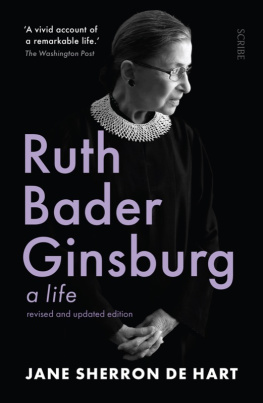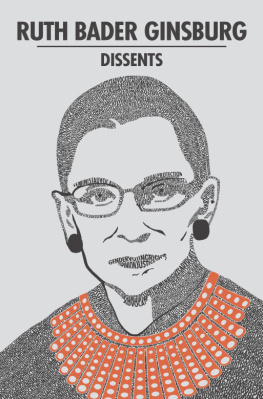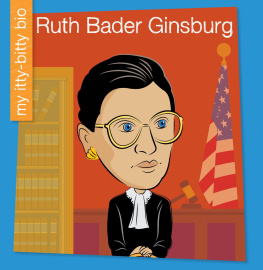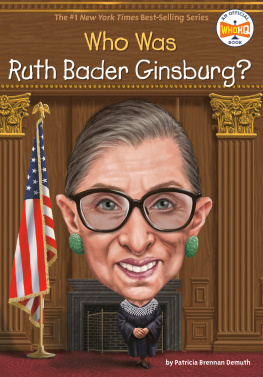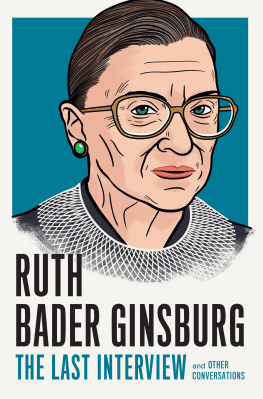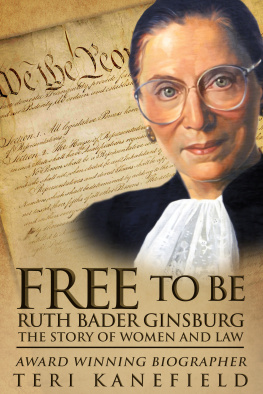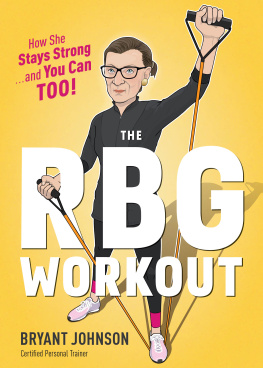Jane Sherron de Hart - Ruth Bader Ginsburg
Here you can read online Jane Sherron de Hart - Ruth Bader Ginsburg full text of the book (entire story) in english for free. Download pdf and epub, get meaning, cover and reviews about this ebook. year: 2020, publisher: Scribe Publications Pty Ltd, genre: Non-fiction. Description of the work, (preface) as well as reviews are available. Best literature library LitArk.com created for fans of good reading and offers a wide selection of genres:
Romance novel
Science fiction
Adventure
Detective
Science
History
Home and family
Prose
Art
Politics
Computer
Non-fiction
Religion
Business
Children
Humor
Choose a favorite category and find really read worthwhile books. Enjoy immersion in the world of imagination, feel the emotions of the characters or learn something new for yourself, make an fascinating discovery.
- Book:Ruth Bader Ginsburg
- Author:
- Publisher:Scribe Publications Pty Ltd
- Genre:
- Year:2020
- Rating:4 / 5
- Favourites:Add to favourites
- Your mark:
- 80
- 1
- 2
- 3
- 4
- 5
Ruth Bader Ginsburg: summary, description and annotation
We offer to read an annotation, description, summary or preface (depends on what the author of the book "Ruth Bader Ginsburg" wrote himself). If you haven't found the necessary information about the book — write in the comments, we will try to find it.
Ruth Bader Ginsburg — read online for free the complete book (whole text) full work
Below is the text of the book, divided by pages. System saving the place of the last page read, allows you to conveniently read the book "Ruth Bader Ginsburg" online for free, without having to search again every time where you left off. Put a bookmark, and you can go to the page where you finished reading at any time.
Font size:
Interval:
Bookmark:

RUTH BADER GINSBURG
Jane Sherron De Hart is a professor emerita of history at the University of California, Santa Barbara. She lives in Santa Barbara, California.
Scribe Publications
1820 Edward St, Brunswick, Victoria 3056, Australia
2 John St, Clerkenwell, London, WC1N 2ES, United Kingdom
First published in 2018 by Alfred A. Knopf, a division of Penguin Random House LLC
Revised edition published by Scribe 2020 with permission of the author
Copyright Jane Sherron De Hart 2018, 2020
All rights reserved. Without limiting the rights under copyright reserved above, no part of this publication may be reproduced, stored in or introduced into a retrieval system, or transmitted, in any form or by any means (electronic, mechanical, photocopying, recording or otherwise) without the prior written permission of the publishers of this book.
The moral right of the author has been asserted.
9781922310736 (Australian edition)
9781913348496 (UK edition)
9781925938906 (ebook)
Catalogue records for this book are available from the National Library of Australia and the British Library.
scribepublications.com.au
scribepublications.co.uk
For Jerry
for unwavering love and support
Contents
Preface:
PART I Becoming Ruth
PART II Mounting a Campaign
PART III Learning Under Fire
PART IV Moving Forward
PART V Becoming Judge and Justice
PART VI Standing Firm
Epilogue:
Preface
An American Icon
The year was 1993. The president of the United States strode toward the lectern in the White House Rose Garden, accompanied by a diminutive sixty-year-old woman in a cobalt-blue suit and dark sunglasses. Before a bipartisan sprinkling of the Senate Judiciary Committee, family members, friends, and the national press, Bill Clinton presented his replacement for the retiring justice Byron WhiteJudge Ruth Bader Ginsburg.
In the months and years ahead, he predicted, the nation would come to know much more about the woman at his side. People will find, as I have, he pledged, that this nominee is a person of immense character. Quite simply, whats in her record speaks volumes about what is in her heart. She has stood for the individual, the person less well off, the outsider in society, and has given them greater hope by telling them that they have a place in our legal system. Indeed, Clinton continued, many admirers of her work say she is to the womens movement what former Supreme Court Justice Thurgood Marshall was to the movement for African Americans.
Following the president to the lectern, the nominee responded graciously. Thanking himand especially New Yorks senator Daniel Patrick Moynihan, who first brought her to Clintons attentionshe followed the introduction of her family with a statement that was at once personal and political. The announcement the President made is significant, I believe, because it contributes to the end of the days when women, at least half the talent pool in our society, appear in high places only as one-at-a-time performers. Noting that Justice Sandra Day OConnor was sitting on the Supreme Court and nearly twenty-five women served on the U.S. Court of Appeals, two as chief judges, she predicted that more would follow.
She then recalled her daughters 1973 high school yearbook, where her firstborn, Jane, had listed under ambition her hope to see her mother nominated to the Supreme Court. The next line read, If necessary, Jane will appoint her. Jane is so pleased, Mr. President, that you did it instead, and her brother, James, is, too.
Then Ginsburg turned to the many to whom she felt indebted: a revived womens movement and the civil rights movement of the 1960s, from which feminists in the United States had drawn inspiration, as well as colleagues and family. And with a deft touch, she mentioned that this was not the first time that a member of her family had stood next to Hillary Rodham Clinton, whom she herself had met just that day. There is another I love dearly with whom the First Lady is already an old friend. Holding up a photograph of Mrs. Clinton surrounded by nursery school children singing The Toothbrush Song, she pointed to my wonderful granddaughter, Clara. She also thanked her husband, Marty, my best friend and biggest booster, her mother-in-law, Evelyn, the most supportive parent a person could have, and children with tastes to appreciate that Daddy cooks ever so much better than Mommy and so phased me out of the kitchen at a relatively early age. She concluded with a tribute to her mother, Celia Amster Bader, the bravest and strongest person I have ever known.... I pray that I may be all that she would have been had she lived in an age when women could aspire and achieve, and daughters are as much cherished as sons. Those final words left the president fighting back tears.
AS I WATCHED the ceremony on the evening news, it never occurred to me that five years later I might actually meet the justice, much less write about her. My work as a historian had taken a new turn when I began exploring the dual constitutional strategy that had been devised by feminist lawyers in the late 1960s to secure gender equality in the law. One prong of that strategy sought ratification of an equal rights amendment (ERA) to the Constitution prohibiting gender-based discrimination. The other, closely related, called for litigation efforts to persuade the Supreme Court to strike down laws that discriminated on the basis of gender. Ginsburg, then a law professor at Rutgers and later at Columbia University, spearheaded the latter effort in the 1970s under the auspices of the Womens Rights Project of the American Civil Liberties Union (ACLU).
Having lately completed a fine-grained analysis of efforts in a key southern state that twice came two votes short of ratifying the amendment, I had turned to another project. Midway into that exercise, I began research for a chapter in which I hoped to make use of Ginsburgs womens rights litigation as an example of judicial policy making. Heading to the Seeley Mudd Library at Princeton University, where the archives for the ACLU are deposited, I wanted to understand how, in less than a decade, a law professor known primarily for her expertise in civil procedure and comparative law, someone who prior to 1973 had never argued a case before the Supreme Court, became the nations foremost litigator for gender equality. Being in the right place at the right timeGinsburgs characteristically modest explanationtells part of the story. But it does not explain how she acquired the capacious vision of equality that she brought to her litigation, her strategic sensibility, or her passion for justice.
I found just one case file containing correspondence between the ACLUs legal director Melvin Wulf and Kiki Ginsburg, who had volunteered to write the brief for a test case known as Reed v. Reed . Her brief won the case, convincing the justices for the first time in the nations history that gender-based discrimination violated the equal protection clause of the Fourteenth Amendment. Eager to see files for her cases following Reed, I asked for the records of the Womens Rights Project. They were not at the Seeley Mudd Library, I was told; they must still be in New York at the ACLUs national office. Regrettably, they were not. Indeed, nobody seemed to know where they were. When I finally appealed to Justice Ginsburg to help track down the records, she discovered that they had been lost in a move of the ACLUs headquarters. Offering to make her own files available, she had the material transported to the Manuscript Division of the Library of Congress the day before I arrived in Washington in October 1998.
Next pageFont size:
Interval:
Bookmark:
Similar books «Ruth Bader Ginsburg»
Look at similar books to Ruth Bader Ginsburg. We have selected literature similar in name and meaning in the hope of providing readers with more options to find new, interesting, not yet read works.
Discussion, reviews of the book Ruth Bader Ginsburg and just readers' own opinions. Leave your comments, write what you think about the work, its meaning or the main characters. Specify what exactly you liked and what you didn't like, and why you think so.

